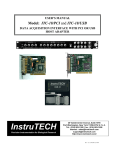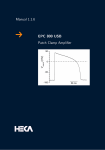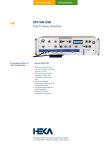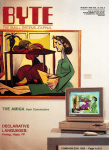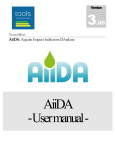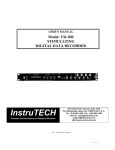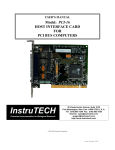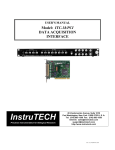Download LIH 8+8 Manual - HEKA Elektronik Dr. Schulze GmbH
Transcript
Manual 1.0 LIH 8+8 Data Acquisition Interface HEKA Elektronik Dr. Schulze GmbH Wiesenstrae 71 D-67466 Lambrecht/Pfalz Germany Phone Fax Web Site Email +49 (0) 6325 / 95 53-0 +49 (0) 6325 / 95 53-50 http://www.heka.com [email protected] [email protected] HEKA Electronics Inc. 47 Keddy Bridge Road R.R. #2 Mahone Bay, NS B0J 2E0 Canada Phone Fax Web Site Email +1 902 624 0606 +1 902 624 0310 http://www.heka.com [email protected] [email protected] HEKA Instruments Inc. 20E Vanderventer Ave Suite 102 Port Washington, NY 11050 U.S.A. Phone Fax Web Site Email +1 516 882 1155 +1 516 467 3125 http://www.heka.com [email protected] [email protected] Title Page: LIH 8+8 Acquisition Interface © 2007 HEKA Elektronik Dr. Schulze GmbH COMLMA/1 Contents 1 Introduction 1 1.1 Product Intended Usage . . . . . . . . . . . . . . . . . . . . 1 1.2 Supplied Components . . . . . . . . . . . . . . . . . . . . . 1 1.2.1 For a single rack unit: . . . . . . . . . . . . . . . . . 1 1.2.2 For a dual rack unit: . . . . . . . . . . . . . . . . . . 2 1.3 Unpacking . . . . . . . . . . . . . . . . . . . . . . . . . . . . 2 1.4 Computer Requirements . . . . . . . . . . . . . . . . . . . . 2 1.4.1 Macintosh . . . . . . . . . . . . . . . . . . . . . . . . 2 1.4.2 Windows . . . . . . . . . . . . . . . . . . . . . . . . 3 Hardware Description . . . . . . . . . . . . . . . . . . . . . 3 1.5.1 Main Features: . . . . . . . . . . . . . . . . . . . . . 4 1.5.2 Hardware Configuration . . . . . . . . . . . . . . . . 4 1.5.3 Isolation . . . . . . . . . . . . . . . . . . . . . . . . . 5 1.5.4 Analog Circuitry . . . . . . . . . . . . . . . . . . . . 5 1.5.5 Differential Inputs . . . . . . . . . . . . . . . . . . . 7 1.5.6 FIFO Memory . . . . . . . . . . . . . . . . . . . . . 7 1.5.7 USB 2.0 Benefits . . . . . . . . . . . . . . . . . . . . 7 1.5.8 Expandability . . . . . . . . . . . . . . . . . . . . . . 8 1.5.9 Tone Generator . . . . . . . . . . . . . . . . . . . . . 9 1.5.10 Software Support . . . . . . . . . . . . . . . . . . . . 9 1.5 ii CONTENTS 2 Technical Specifications 11 2.1 Analog Inputs . . . . . . . . . . . . . . . . . . . . . . . . . . 11 2.2 Digital Inputs . . . . . . . . . . . . . . . . . . . . . . . . . . 11 2.3 Trigger Input . . . . . . . . . . . . . . . . . . . . . . . . . . 12 2.4 Analog Outputs . . . . . . . . . . . . . . . . . . . . . . . . . 12 2.5 Digital Outputs . . . . . . . . . . . . . . . . . . . . . . . . . 12 2.6 Tone Generator . . . . . . . . . . . . . . . . . . . . . . . . . 13 2.7 Additional Connectors . . . . . . . . . . . . . . . . . . . . . 13 2.8 Dimensions . . . . . . . . . . . . . . . . . . . . . . . . . . . 13 2.9 Power Requirements . . . . . . . . . . . . . . . . . . . . . . 13 2.10 Cables . . . . . . . . . . . . . . . . . . . . . . . . . . . . . . 13 2.11 Host Interface . . . . . . . . . . . . . . . . . . . . . . . . . . 14 2.12 Warranty . . . . . . . . . . . . . . . . . . . . . . . . . . . . 14 3 Installation 3.1 Connecting the LIH 8+8 . . . . . . . . . . . . . . . . . . . . 4 Controls and Functions 15 15 17 4.1 Front-panel Controls . . . . . . . . . . . . . . . . . . . . . . 17 4.2 Rear panel controls . . . . . . . . . . . . . . . . . . . . . . . 20 5 Troubleshooting 23 6 Warranty and Support 35 6.1 Warranty . . . . . . . . . . . . . . . . . . . . . . . . . . . . 35 6.2 Limitation of Liability . . . . . . . . . . . . . . . . . . . . . 36 6.3 Obtaining Warranty Service . . . . . . . . . . . . . . . . . . 37 http://www.heka.com CONTENTS iii 6.4 Obtaining Out-of-Warranty Service . . . . . . . . . . . . . . 37 6.5 Technical Support . . . . . . . . . . . . . . . . . . . . . . . 37 7 Appendix I: Technical Data 39 7.1 DIGITAL I/O Connector . . . . . . . . . . . . . . . . . . . 39 7.2 DIGITAL IN Connector . . . . . . . . . . . . . . . . . . . . 41 7.3 DIGITAL OUT Connector . . . . . . . . . . . . . . . . . . . 42 http://www.heka.com List of Figures 1.1 Schematic illustrating 100 µs data acquisition of two pairs of input channels (AD-0, AD-1 and AD-2, AD-3). The 5 µs time delay is shown in the insert. . . . . . . . . . . . . . . . 6 4.1 LIH 8+8 Front Panel Controls . . . . . . . . . . . . . . . . 17 4.2 LIH 8+8 Rear Panel Controls . . . . . . . . . . . . . . . . . 20 7.1 Digital I/O Connector . . . . . . . . . . . . . . . . . . . . . 40 7.2 Digital IN Connector . . . . . . . . . . . . . . . . . . . . . . 41 7.3 Digital OUT Connector . . . . . . . . . . . . . . . . . . . . 42 1. Introduction 1.1 Product Intended Usage The HEKA LIH 8+8 is intended for research use only in a laboratory by persons trained in its use. Users are expected to be able to properly operate the LIH 8+8 and associated instruments. The HEKA LIH 8+8 is not intended for medical use. The HEKA LIH 8+8 is not intended for use in life support situations, or in situations were improper operation or failure of the LIH 8+8 can result in personal injury. HEKA makes no representation that the design, implementation, testing, or manufacture of the LIH 8+8 meet reasonable standards for use as a medical product. As stated in the HEKA Limited Warranty Statement, supplied with each product, HEKA expressly disclaims all warranties to buyer except the limited warranty set forth above, including without limitation to any and all implied warranties of merchantability and fitness for a particular purpose.” 1.2 Supplied Components The following items should have been packed with your LIH 8+8 Data Acquisition System: 1.2.1 For a single rack unit: 1 LIH 8+8 data acquisition interface 1 USB 2.0 shielded cable (3 meters) 1 HEKA CD-ROM 2 Introduction 1 Printed user’s manual 1 power cord (110 or 220 Volt depending on application) 1.2.2 For a dual rack unit: 2 LIH 8+8 data acquisition interface 2 USB 2.0 shielded cable (3 meters) 1 HEKA CD-ROM 1 Printed user’s manual 2 power cord (110 or 220 Volt depending on application) If any of these items are missing please contact HEKA or your dealer immediately. 1.3 Unpacking After unpacking the LIH 8+8 and accessories from the shipping carton, please inspect each piece for any signs of shipping damage. Please contact the delivering carrier and HEKA immediately if there is any damage. Do not dispose of the shipping carton. The carrier will want to examine the shipping carton to process a damage claim. HEKA insures all shipments to cover shipping damage. It is also advisable to keep the shipping carton in the event that the instrument must be returned for service. 1.4 1.4.1 Computer Requirements Macintosh Macintosh G5 or faster processor Mac OS X (10.39 or higher) http://www.heka.com 1.5 Hardware Description 3 Available USB 2.0 Hi-Speed port (480 Mbits/second) CD-ROM or internet access 1.4.2 Windows Pentium 4 or faster processor Windows 2000, XP or Vista Available USB 2.0 Hi-Speed port (480 Mbits/second) CD-ROM or internet access Please note that many newer computer systems are supplied with multiple USB 2.0 ports, but only some of these ports are capable of Hi-Speed operation. The LIH 8+8 will work on the slower speed ports, but the maximum transfer rates will be greatly reduced. For optimal performance, the LIH 8+8 should only be connected to a USB 2.0 Hi-Speed port. If your computer system does not have a Hi-Speed USB 2.0 port, then a USB 2.0 adapter may be used. These adapters are available in many configurations (PCI, PC Slot, etc). 1.5 Hardware Description The LIH 8+8 is a high resolution, low-noise scientific data acquisition system. It was specifically designed for electrophysiological applications, but it’s versatility, allows it to be used for any general purpose data acquisition need. The LIH 8+8 utilizes the latest Analog to Digital, Digital to Analog, USB 2.0 and high-speed processor technologies to provide expandability and versatility for all current and future requirements. With it’s USB 2.0 Hi-Speed interface, the LIH 8+8 is truly a plug-and-play device that can be easily migrated from various computer systems and measuring setups. http://www.heka.com 4 Introduction 1.5.1 Main Features: Expandable fully synchronized data acquisition system All synchronous analog and digital channels are isolated Eight differential analog input channels Two 16-bit 200 kHz A/D converters multiplexed into two banks of four input channels Simultaneous sampling on two channels (one from each bank) at 200 kHz per channel, 400 kHz aggregate rate Analog input / output range: ±10.24 Volts Four 16-bit pseudo differential analog output channels Sixteen synchronous digital input channels Sixteen synchronous digital output channels Master / Slave clock circuitry for multi-unit synchronization USB 2.0 host interface offers true plug-and-play installation Can be used with Laptop and small form factor computer systems (iMac, Mac mini, etc) Compatible with Windows (2000, XP, and Vista), Mac OS X (10.39 and above, PPC or Intel processor) 1.5.2 Hardware Configuration The LIH 8+8 is a rack-mountable data acquisition unit. It has BNC connectors on the front panel for the eight analog inputs, the four analog outputs, and four each of the digital inputs and outputs. All of the digital input and output lines are available on ribbon-cable connectors located on the rear panel. The LIH 8+8 is connected to a host computer’s USB 2.0 Hi-Speed (480 Mbits/second) port over a shielded USB 2.0 cable (3 meters). The LIH 8+8 is compatible with Mac OS X (10.39 and above) http://www.heka.com 1.5 Hardware Description 5 and Windows (2000, XP or Vista). The host operating system treats the LIH 8+8 as it would any Flash memory device. Therefore only standard operating system files are required. Moving the LIH 8+8 from one computer platform to another is a simple matter of connecting a USB cable and installing the proper data acquisition software. 1.5.3 Isolation All of the analog input and output channels of the LIH 8+8 are isolated from the digital electronics used to communicate with the computer. This isolation is achieved with state of the art high-speed digital isolator’s. This isolation is provided to eliminate computer electrical noise from the analog measurements. Computers contain digital electronics that switch at high-speed producing large electrical transients. The computer ground functions as the return path for these transients resulting in substantial high-frequency ground noise. Each analog input and output channel of the LIH 8+8 has it’s own separate ground path that is isolated from the computer ground. Therefore, computer ground noise is not coupled into the measurement. Isolation is almost essential if low-noise analog outputs are provided as with the LIH 8+8. If the analog outputs are not electrically isolated from the computer ground, the analog output ground will contain computer-generated noise. This is one of the major ways by which computer-generated noise is introduced into a measurement system. The isolation of the LIH 8+8 brings with it another benefit that simplifies complex measurement systems. Since the analog inputs and outputs of the LIH 8+8 float with respect to ground, the LIH 8+8 and the host computer are not a source of ground loop problems. 1.5.4 Analog Circuitry The LIH 8+8 provides eight analog differential inputs, four analog pseudodifferential outputs, sixteen digital inputs and sixteen digital outputs. All channels are sampled synchronously. The eight analog input channels are separated into two banks of four. One bank is comprised of A/D input channels 0,2,4 and 6 and the other of 1,3,5 and 7. Each bank is multiplexed into one 16-bit 200 kHz A/D converter. http://www.heka.com 6 Introduction Both A/D converters sample simultaneously at the maximum conversion rate resulting in a total throughput of 400 kHz. If the bandwidth of the experiment calls for lower sampling rates, then the hardware will adjust the rate accordingly. The simultaneous sampling arrangement allows pairs of channels, for example the Current and Voltage signals from a Patch Clamp Amplifier, to be digitized without phase-shift. The analysis of high-frequency correlation between these cophasic signals is simplified since there is no time offset between sample points on these input channels. Also, during this cophasic acquisition, there will be no time delay between the firing of two D/A channels and the sampled inputs. If more than one pair of input channels are acquired, then a 5 µs sampling delay will occur. See illustration below. Figure 1.1: Schematic illustrating 100 µs data acquisition of two pairs of input channels (AD-0, AD-1 and AD-2, AD-3). The 5 µs time delay is shown in the insert. The four 16-bit D/A converters feature high accuracy with low noise. This low noise allows for the observation of least significant bit transitions. The D/A converters update simultaneously. http://www.heka.com 1.5 Hardware Description 1.5.5 7 Differential Inputs The LIH 8+8 was designed with differential A/D inputs to provide the most accurate measurements. Differential inputs are isolated inputs since they are referenced to a ground point that is not connected to earth ground. Therefore, differential inputs eliminate common-mode voltage errors that can occur and are required for measuring low-level signals. Other data acquisition interfaces that use single-ended analog inputs are non-isolated inputs that are referenced to earth ground. Non-isolated systems also connect the digital I/O signals to the same ground. If the recording setup shares the same ground as the data acquisition interface, typically via the building’s AC power, the difference in ground potential between the two devices can be substantial. Fast switching currents must then travel between the various devices of the recording setup to the computer. Depending on how single-ended inputs are connected, ground-loop errors can be introduced resulting in inaccurate measurements. 1.5.6 FIFO Memory The LIH 8+8 is supplied with two 512 kilosample FIFOs, one each for input and output data points. The combination of these FIFOs and the high-speed data transfer of the USB Bus allows high-speed continuous data acquisition to be performed independent of the activity of the host computer. 1.5.7 USB 2.0 Benefits 1.5.7.1 True Plug-and-Play Simply connect the LIH 8+8 to an available Hi-Speed USB 2.0 port on the host computer system using the supplied USB cable. The computer will automatically identify the LIH 8+8 and install the appropriate system drivers, if needed. This connection scheme greatly reduces start-up time. It is no longer necessary to open the computer to add a board. Simply make all of the connections to the recording setup and execute the data acquisition software. Within minutes, data can be acquired. http://www.heka.com 8 Introduction 1.5.7.2 Greater Computer Support In the past, many data acquisition devices could only be interfaced to highend desktop computers with available bus slots (i.e. ISA, PCI, etc). This typically meant that only larger foot-print and more expensive computer systems could be used. Today, virtually all desktop and laptop computers on the market provide USB ports. It is now possible to use low-cost, small form factor systems (i.e. iMac, Mac mini, etc) with the LIH 8+8 for data acquisition applications. 1.5.7.3 Hot-Swappable Another advantage of the USB based LIH 8+8 data acquisition interface is that it can be installed or removed while the computer is running. Just plug the device in, use it, and unplug it when done. There is no need to power down the computer. The LIH 8+8 is self-enumerating and selfidentifying. The device driver is dynamically loaded when connected and dynamically unloaded when unplugged. 1.5.8 Expandability If an application requires more channels than are available on a single LIH 8+8, then multiple units can be connected and fully synchronized. Each LIH 8+8 unit requires a dedicated Hi-Speed USB 2.0 port and an external cable connection between the units. This external connection is used to synchronize the acquisition clocks of the units and is made with a standard CAT5 patch cable. Note that LIH 8+8 interfaces installed on separate computers use a single external trigger to start the multiple units simultaneously. Important note: The hardware design of the LIH 8+8 will allow any number of units to be installed, only limited by the number of available Hi-Speed USB 2.0 ports. Currently there is a software limitation which only allows one master /slave combination, basically doubling all of the input and output channels. http://www.heka.com 1.5 Hardware Description 1.5.9 9 Tone Generator The LIH 8+8 has a built-in tone generator that is controlled by software. The tone generator has a frequency range between 200 Hz and 4 kHz. A 3.5 mm audio connector is provided on the rear panel for connection to an amplified speaker or headset. One of the features of the PATCHMASTER software is the capability to play a sound that is proportional to R-membrane. This is typically used for monitoring seal-resistance. This feature was originally supported via the sound output hardware of the host computer. Over the years many sound board and chipset manufacturers dropped support of various commands that were used by PATCHMASTER to generate this sound. This made it very difficult to support this feature other than on a few computer systems. By adding the tone generator directly to the data acquisition interface, this feature can now be easily supported in all computer systems without any additional hardware or software. 1.5.10 Software Support The LIH 8+8 is fully supported by the following HEKA software packages: PATCHMASTER CHARTMASTER POTMASTER TIDA A Windows DLL (Dynamic Link Library) is available for software developers that are interested in writing their own Windows applications. Please contact HEKA for further details. IgorPro XOPs (“external operations”) are also available for controlling the LIH 8+8 directly from WaveMetrics IgorPro (5.0 or later) software. The LIH XOP’s are free of charge, and can be downloaded directly from the HEKA website. Please note that currently, only a Windows version is available. http://www.heka.com 10 http://www.heka.com Introduction 2. Technical Specifications 2.1 Analog Inputs Number of channels: Input type: Input connector: Resolution: Sampling rate: Input range: Differential non-linearity: Drift: Input impedance: Signal to noise ratio: No missing codes: Crosstalk between ADC: Crosstalk between banks: Maximum over voltage: 2.2 8 2 ADC multiplexed into 4 inputs Bank 0 - channels 0,2,4 and 6 Bank 1 - channels 1,3,5, and 7 differential, isolated BNC on front panel 16-bit, (1 in 65536) 400 kHz aggregate, 200 kHz per ADC -10.24 to +10.239 Volts 0.002 % of FSR ±2 ppm/ 1 MΩ 86 dB at DC to 160 kHz, <1 mV PP 16-bit not measurable -110 dB, 20 Volt 1 kHz sine wave input ±35 Volts Digital Inputs Number of channels: Input type: Minimum pulse width: Input connectors: Maximum over voltage: 16, isolated 3.3 and 5 Volt logic compatible 150 ns 3 on front panel BNC all on rear panel DB-25 connector ±30 Volts D.C. 12 2.3 Technical Specifications Trigger Input Number of channels: Input type: Minimum pulse width: Operational mode: Input connector: Maximum over voltage: 2.4 Analog Outputs Number of channels: Output type: Output connector: Resolution: Settling time: Output range: Gain error: Gain linearity: Drift: Output impedance: Signal to noise ratio: Short circuit to ground: Current output: 2.5 1, isolated 3.3 and 5 Volt logic compatible 30 ns software selectable positive or negative edge transition BNC on front panel ±30 Volts D.C. 4, individual DAC pseudo differential, isolated BNC on front panel 16-bit, (1 in 65536) <1 µs -10.24 to +10.239 Volts 0.2 % of FSR <2 dB ±4 ppm/ 4.7 Ω 116 dB indefinite ±20 mA maximum Digital Outputs Number of channels: Input type: Input connectors: Power-on state: Maximum output current: http://www.heka.com 16, isolated TTL logic compatible 4 on front panel BNC all on rear panel DB-25 connector logic low ±35 mA 2.6 Tone Generator 2.6 Tone Generator Frequency range: Output connector: 2.7 Master sync: Slave sync: USB 2.0 female B connector on rear panel 40 pin male connector on rear panel for interfacing with EPC 8 or TIB 14 RJ-45 (CAT5) connector on rear panel RJ-45 (CAT5) connector on rear panel Dimensions Width: Height: Depth: Weight: 2.9 47.5 cm (19 inches) 19 inch rack mountable 4.375 cm (1.75 inches) 31.1 cm (12.5 inches) 3.6 kg (8 pounds) Power Requirements Input voltage: Input frequency: Maximum power: 2.10 between 200 Hz and 4 kHz 3.5 mm audio jack on rear panel Additional Connectors USB: Digital IO: 2.8 13 90 VAC - 250 VAC 50/60 Hz 30 watts Cables USB: Power cord: 3 meter USB 2.0 shielded cable 2 meter IEC type supplied with either a USA, UK, AU or EU version http://www.heka.com 14 2.11 Technical Specifications Host Interface USB 2.0: 2.12 Hi-Speed (480 Mbits/second) Warranty Duration: One year parts and labor http://www.heka.com 3. Installation 3.1 Connecting the LIH 8+8 1. The LIH 8+8 can be installed into a standard nineteen-inch instrument rack or used as a desktop unit. If installing on a rack, please do not use the LIH 8+8 as a shelf to support any other instrument. The LIH 8+8 case was not designed to do this and damage to the front panel will result. To minimize noise, it is advisable to mount the LIH 8+8 away from devices that emit high-frequency signals (i.e monitors, power supplies, etc). 2. Connect the power cord to the LIH 8+8. The internal power supply used in the LIH 8+8 is an auto switching multi-voltage supply that will operate from 90 Volts to 250 Volts. Make sure that the LIH 8+8 power cord is plugged into a properly grounded AC receptacle. Improper grounding of the LIH 8+8 could result in an electrical shock hazard. It is advisable to plug all equipment into a common outlet strip. This will minimize power line induced noise in the system. 3. Install the USB cable from the USB connector on the rear panel of the LIH 8+8, labeled USB, to an available USB 2.0 Hi-Speed port on the computer. This connection should be made directly to the computers USB 2.0 port and not to a USB HUB. 4. As soon as the LIH 8+8 is detected by the host operating system the appropriate system files will be initialized and the LIH 8+8 will be ready for use. Important note: The host operating system treats the LIH 8+8 as it would any Flash memory device. Therefore, only standard operating system files are required. This provides ease of installation and flexibility for moving the LIH 8+8 from one computer system to another. 16 Installation 5. If multiple LIH 8+8 interfaces are to be connected, repeat the steps as outlined above for each unit. In addition, for the acquisition clocks to be properly synchronized, a connection between the Master clock output of one unit to the Slave clock input of the other (connectors located on the rear panel) must be made using standard CAT5 patch cables. Important note: Please note that the sync clock is a highfrequency signal. The shortest possible length patch cable should be used. 6. Before powering up, please recheck all connections. If all connections are proper then the power LED will illuminate once the LIH 8+8 is powered ON. Important note: Please note that the Status LED will not be illuminated until the acquisition software has initialized the interface. The LIH 8+8 is now connected and ready to go. http://www.heka.com 4. Controls and Functions 4.1 Front-panel Controls Figure 4.1: LIH 8+8 Front Panel Controls 1. DAC Outputs: Four BNC connectors provide access to the four individual 16-bit Digital to Analog converter outputs. The acquisition software controls the D/A channels output voltage and timing. The D/A channels have an output range of ±10.24 Volts and can be simultaneously used for waveform generation. The D/A channels are isolated from the computer. For optimal results, use only high-quality 75 Ω BNC cables. Important note: Do not under any circumstances connect an output to any of the D/A channels. Otherwise the D/A circuitry can be damaged. 2. ADC Inputs: Eight BNC connectors provide access to the 16-bit Analog to Digital converter input channels. The eight analog input 18 Controls and Functions channels are separated into two banks of four. Each bank is multiplexed into one 16-bit 200 kHz A/D converter. The acquisition software controls the A/D channel selection and sampling interval timing. The A/D channels have an input range of ±10.24 Volts. These channels are isolated from the computer. For optimal results, use only high-quality 75 Ω BNC cables. Also, since the A/D channels are differential, the BNC cables must have a very good continuous shield to both ends of the cable. The shield of the BNC connector must also have a reference connected to it. If the BNC connector shield is left unconnected unexpected results can occur. Important note: Do not under any circumstances exceed the maximum input voltage allowed of 15 Volts peak. 3. Status Indicator LED: The Status LED will be illuminated when the LIH 8+8 has been properly initialized and ready for use. 4. External Trigger Input: A BNC connector provides access to the Trigger input circuitry of the LIH 8+8. A TTL trigger pulse can be given to start data acquisition. The LIH 8+8 can be triggered with either a positive or negative logic pulse, depending on software settings, with a minimum duration of 30 ns. This input is isolated from the computer. Important note: The absolute maximum voltage range for this input is -0.5 to +5.5 Volts. Do not exceed this range or damage can result to the input circuitry. 5. Digital Inputs: Three BNC connectors provide access to three of the sixteen Digital Input channels. These Digital Inputs can be read by the acquisition software. These Digital Input channels accept standard TTL level inputs (5 Volts and 0 Volts). These channels are isolated from the computer. For optimal results, use only high-quality 75 Ω BNC cables. Important note: The absolute maximum input voltage range is -0.5 to +5.5 Volts. Do not exceed this range or damage can result to the input circuitry. http://www.heka.com 4.1 Front-panel Controls 19 6. Digital Outputs: Four BNC connectors provide access to four of the sixteen Digital Output channels. The acquisition software can control the state of the Digital Output channels. These Digital channels output standard TTL levels (5 Volts and 0 Volts). These channels are isolated from the computer. For optimal results, use only highquality 75 Ω BNC cables. 7. Chassis Ground: A 4 mm banana receptacle provides connection to the chassis ground of the LIH 8+8 interface. 8. Power Indicator LED: The power LED will be illuminated when the LIH 8+8 is connected to the power line and switched ON. http://www.heka.com 20 Controls and Functions 4.2 Rear panel controls Figure 4.2: LIH 8+8 Rear Panel Controls 1. Power Switch: A rocker-style On/Off switch is used to control the LIH 8+8. When the switch is toggled to the ON position, then the green Power LED indicator on the front panel will be illuminated. 2. Line Power Input: A three wire male IEC connecter accepts standard three wire IEC female type power cords. The appropriate power cord has been provided with the LIH 8+8. The internal power supply used in the LIH 8+8 is an auto- switching multi-voltage supply that will operate from 90 Volts to 250 Volts. It is advisable to plug all equipment into a common outlet strip. This will minimize power line induced noise (sixty / fifty hertz signals) in the acquired data. Important note: To avoid a shock hazard, the LIH 8+8 must be plugged into a properly grounded AC power outlet. 3. Fuse: A F1.0A 20 mm fuse is used to protect the internal power supply of the LIH 8+8. If the fuse needs to be replaced, only replace with a 20 mm type F1.0A fuse. 4. Digital Outputs: A DB-25 female connector provides access to the sixteen isolated digital output lines. Four of the sixteen output lines are also brought out on the front panel (OUT-0 to OUT-3). All digital outputs are fully synchronous with the analog I/O and are controlled by the acquisition software. To mate to this connector use 3M electronics 8225-7003 series or equivalent. Pin-out assignments can be found in Appendix I of this manual. http://www.heka.com 4.2 Rear panel controls 21 5. Digital I/O: A 40-pin male connector combines the Digital Output and Input lines of the LIH 8+8. This specialized connector is required for interfacing with other HEKA devices such as the EPC 8 Patch Clamp Amplifier or the TIB 14S Trigger Interface. To mate to this connector use 3M electronics 3417 series or equivalent. Pin-out assignments can be found in Appendix I of this manual. Important note: The Digital Output and Input lines on this connector are parallel to the main Digital OUT and Digital IN lines and not in addition to. 6. Digital Inputs: A DB-25 male connector provides access to the sixteen isolated Digital Input lines. Three of the sixteen input lines are also brought out on the front panel (IN-0 to IN-2). All Digital Inputs are fully synchronous with the analog I/O and can be read by the acquisition software. To mate to this connector use 3M electronics 8225-7003 series or equivalent. Pin-out assignments can be found in Appendix I of this manual. Important note: The absolute maximum voltage range for these inputs is -0.5 to +5.5 Volts. Do not exceed this range or damage can result to the input circuitry. 7. Slave Sync: A RJ-45 connector provides the clock input for synchronizing acquisition clocks between LIH 8+8 interfaces. A standard CAT5 patch cable is used to connect the Master output of one unit to the Slave input of the other. Important note: This is a high-frequency clock signal. To minimize jitter and noise, use the shortest length patch cable possible. 8. USB 2.0: A USB 2.0 type B female connector for attaching a USB cable which enables connection to the host computer’s Hi-Speed USB 2.0 port. Important note: Only a shielded USB 2.0 cable should be used. Non-shielded cables can lead to USB communication errors. Also, the LIH 8+8 should only be directly connected to the computers Hi-Speed USB 2.0 port. http://www.heka.com 22 Controls and Functions 9. Master Sync: A RJ-45 connector provides a 33 MHz clock output for synchronizing the acquisition clocks between LIH 8+8 interfaces. A standard CAT5 patch cable is used to connect the Master output of one unit to the Slave input of the other. Important note: This is a high-frequency clock signal. To minimize jitter and noise use the shortest length patch cable possible. 10. Sound Output: A standard 3.5 mm audio connector is provided for connection to an amplified speaker or headset. The tone generator has a frequency range between 200 Hz and 4 kHz which is controlled by software. http://www.heka.com 5. Troubleshooting Most problems arise from incorrect installation of the hardware, and/or incorrect use of the software. When troubleshooting, it is best to simplify both software and hardware configurations as to remove as many unknowns as possible. This chapter will address some of the most common problems. Make sure that no other programs are actively running including virus checking and internet access software. Disconnect ALL external instruments and test the LIH 8+8 /computer combination by itself. If possible, swap in a known working LIH 8+8 as a quick way to determine if the problem is the LIH 8+8 or the computer. Make sure that the latest versions of the application software are installed. 1. Power Switch not Illuminated: (a) First check that the power switch, located on the rear panel, is toggled to the ON position. (b) Check to see that the AC line cord is plugged in correctly. If attached to a power strip, check that the power strip switch is in the ON position and the circuit breaker has not tripped. (c) Check the fuse located on the rear panel. The fuse can be easily removed by using a flat blade screwdriver. If the fuse needs to be replaced, please use the appropriate fuse type as listed in the Control section of this manual. Important note: Always test the condition of the fuse with either an ohm-meter (Digital Multimeter) or a continuity tester. Visual inspection may not be valid. 24 Troubleshooting 2. Status LED not Illuminated: The Status LED is illuminated once the application program has successfully initialized the LIH 8+8 hardware. The LIH 8+8 cannot be properly initialized if the device driver or the application software is not properly installed. (a) Check that the USB 2.0 cable is firmly attached to both the back of the interface and the host computer. Make sure that the cable is not damaged. (b) If the USB 2.0 cable is attached to a HUB, then disconnect the cable and connect directly to a Hi-Speed USB 2.0 port. (c) Check that a shielded USB 2.0 cable is used. Non-shielded cables can lead to USB communication problems that manifest in a variety of odd behaviors. (d) To verify that the LIH 8+8 is connected please do the following: i. Windows: A. Click on My Computer. B. In the section ”Devices with Removable Storage” the device HEKA LIH88 should be visible. ii. Mac OS X: A. The device HEKA LIH88 will be displayed on the desktop. (e) Hardware Reset: To properly reset the LIH 8+8 two steps are required. First, the power must be cycled OFF and then ON. Next, the USB interface must be reset by disconnecting and reconnecting the USB cable. This will also cause the USB driver to unload and reload. Important note: In a Windows system, if sound is enabled, a beep will be heard when the operating system has loaded / unloaded the USB driver. Once the USB cable is disconnected wait to hear this beep before reconnecting the cable otherwise the driver may not load correctly. 3. Driver Errors: The LIH 8+8 identifies itself to the host operating system without the need of any additional driver files. However, for http://www.heka.com 25 the application software to communicate with the LIH 8+8 the files LIH88Driver.dll and LIH88Service.exe are required. These files are provided and installed by the application program itself. If driver errors are displayed while running the application software, verify that these files exist in the applications working directory. 4. Data Throughput Issues: Data throughput problems can be caused by any number of things including: CPU speed, hard disk speed, available RAM, etc. The following can be easily verified: (a) Check that the LIH 8+8 is connected to a USB 2.0 Hi-Speed port (as outlined above), and that the port is not shared by any other device. USB specifications allows up to 127 devices to be connected on a single USB port. This is very reasonable for low bandwidth devices, but not recommended for high-speed devices like the LIH 8+8 data acquisition system. (b) Check that the acquisition program has enough RAM available. During Acquisition it is advisable to disable any software applications, including virus checkers and screen savers, that are not required. 5. Hardware Verification: The operation of the LIH 8+8 interface can be verified by using the I/O Control Window in either the PATCHMASTER, CHARTMASTER, POTMASTER or EPCMASTER software. The EPCMASTER software is designed specifically for testing the various HEKA amplifiers and interfaces. The EPCMASTER software is available for free download from www.heka.com. A software security key (dongle) is not required. Basic functionality testing of the LIH 8+8 can be performed with any of the above mentioned software applications. The instructions and screen images used in the following procedures are based on the EPCMASTER software. The same basic instructions would apply to all of the other software applications as well. First, the following is a brief description of the basic input conventions used in all of the HEKA software products. This introduction only covers the input types that are needed to properly execute the test procedures outlined below. For a complete description please refer to the user’s manual included with the software package. http://www.heka.com 26 Troubleshooting As with all GUI based software application the HEKA software products rely on the mouse (or other pointing device) for most of the user interaction. An assumption is made that the user has a working knowledge of the operating systems various input devices and conventions. The HEKA software outlined above is supported on both Mac OS and Windows platforms. For the scope of this discussion the only difference between the two is the mouse click. For Window systems that have a multi button mouse, then a left-click is used. For Mac OS systems that have a single button mouse, a single-click is used. The dialog controls used in the I/O Control Window are as follows: Drag box: A number within a box with a drop shadow can be changed by either a mouse drag or keyboard entry. The mouse drag is accomplished by first positioning the mouse pointer over the value. While holding down the left mouse button, drag the mouse up or down to increase / decrease the value. Important note: When the drag mode is active the mouse pointer will change to an up-down arrow combination. When the mouse button is released the value will be set and the mouse pointer will return to it’s original state. Alternatively, the value can be changed via a keyboard entry by either double-clicking on the value, or `Shift´-click, or `Right´-click (Windows), and then typing in the new value. Keyboard input will terminate once the `Return´ or `Enter´ key are pressed. Using `Tab´ will cycle through all Drag items in the active window. Rounded corner rectangle: A text label within a rounded corner rectangle will behave like a momentary switch. To activate the switch, position the mouse pointer on any part of the rectangle and click with the mouse button. Simple rectangles (without drop shadow): A text label within a rectangle is used to display a measured value. http://www.heka.com 27 This dialog is for display only and cannot be changed by the user. Check box: A square box, with or without a text label on the outside of it, behaves like a toggle switch. To toggle the switch, position the mouse pointer on the center of the check box and click with the mouse button. An X within the check box represents an ON condition while a hollow box represents OFF. (a) Start the software application. If the default configuration was saved in a previous session, then hardware and software initialization will begin immediately. Otherwise, the following message window will be displayed. (b) Select Set Defaults. The hardware selection window will be displayed. (c) Select the option EPC 7 and others and the interface LIH 8+8. Since these test procedures are geared for testing the LIH 8+8 the amplifier selection of EPC 7 and others is used to basically specify “no amplifier.” http://www.heka.com 28 Troubleshooting Important note: The procedures outlined below are for testing the stand-alone version of LIH 8+8. They are not to be used for testing the functionality of an LIH 8+8 built into an EPC 10 USB Patch Clamp Amplifier. Those test procedures are outside the scope of this manual. (d) Before selecting Continue verify that the check box Activate AD/DA-board is enabled. Otherwise, the LIH 8+8 interface will not be initialized and the software will execute in “Demo mode.” (e) Select Continue. The software will now proceed with software and hardware initialization. If the software applications Main control window is displayed, this is a positive sign that the LIH 8+8 has been properly detected and initialized. Proper initialization can be visually confirmed by verifying that the Status LED on the front panel is illuminated. If the following error window is displayed: http://www.heka.com 29 The sound driver is not properly installed. Select retry to initialize the driver once more or abort to terminate the sound driver initialization. If abort, is selected then LIH 8+8 initialization will continue, since this is not considered a fatal error. If any of the following error windows are displayed, testing should be terminated. These errors are considered fatal errors. The driver is not properly installed. Select Exit to terminate the program. Selecting continue will force the software into “Demo mode” resulting in false test results. Important note: Please refer to trouble shooting item “Driver Errors” above for further assistance. (f) To open the I/O Control Window go to the menu bar. Select the menu Window and then I/O Control. The I/O Control window will appear. The controls within this window will be used to verify the basic input and output operation of the LIH 8+8. http://www.heka.com 30 Troubleshooting (g) Checking the D/A Outputs: The most accurate way to verify the operation of the D/A channels is with either a Digital Multimeter (DMM or DVM) or an oscilloscope. One of the LIH 8+8 A/D inputs can also be used (if it is known to be working and properly calibrated). i. Connect the D/A channel to be tested directly to the measuring device using the appropriate BNC cable. ii. The D/A channel voltage can be set by using the appropriate drag box dialog located under the label DA-Channels. D/A Channel 0 is the leftmost drag box. The other channels follow in sequence from left to right. Once a new value has been entered, the output voltage on the D/A will be changed. The D/A channel number and value will also be displayed in the Notebook Window. iii. If the value displayed on the measuring device is similar to the specified value, the D/A channel is working correctly. For proper testing output voltages of -10, -5, 0, 5 and 10 Volts should be verified for each output channel. Important note: A minor difference between the set and measured value is normal. If the difference is more than a few millivolts, please contact HEKA technical support for assistance. iv. Repeat the steps outlined above for all remaining D/A channels. http://www.heka.com 31 (h) Checking the A/D Inputs: The most accurate way to verify the operation of the A/D channels is with a calibrated voltage source. If the D/A channels of the LIH 8+8 have been verified they can be used. i. Assuming that a D/A output to be used has been verified (refer to instructions above for reference) connect the D/A to the A/D channel to be tested. ii. Set the D/A output voltage. iii. The measured A/D input will be displayed automatically on the rectangle boxes located under the text label AD-Channels. The readings for A/D channels 0 to 3 are displayed from left to right on the upper row while channels 4 to 7 are on the lower. iv. If the measured value is similar to the D/A output, the A/D channel is working properly. For proper testing, output voltages of -10, -5, 0, 5 and 10 Volts should be used for each input channel. Important note: A minor difference between the output and input value is normal. If the difference is more than a few millivolts please contact HEKA technical support for assistance. v. Repeat the steps outlined above for the remaining A/D channels. (i) Checking the Digital Outputs: The most accurate way to verify the operation of the Digital Outputs is with either a DMM or an oscilloscope. The LIH 8+8 Digital Inputs or A/D channels can also be used (if they are known to be functional). i. Connect the Digital Output to be tested directly to the measuring device. Important note: Digital Outputs 0 to 3 are available on BNC connectors on the front panel and can be easily accessed. All of the Digital Outputs are available on a DB-25 connector on the rear panel labeled “DIGITAL OUT.” To access these channels http://www.heka.com 32 Troubleshooting a breakout cable will have to be fabricated. Please refer to Appendix I of this manual for a complete pin-out description. Important note: It may be tempting to insert the tip of either the oscilloscope probe or the DMM directly into the DB-25 connector, but it is not recommended. Damage to both the probe and connector can occur. ii. First, it is always best to start the test procedure by setting all of the Digital Outputs to a known state. The Clear button provides an easy way to set all of the Digital Outputs to OFF (TTL LOW). iii. There are a couple of ways to control the status of the Digital Outputs. The check box item Single Bit provides a way to set either one or multiple Digital Outputs at a time. If enabled, only one output channel at a time can be active. The others will be automatically cleared. If disabled, the state of multiple channels can be changed. iv. The Digital Output state can be set either by toggling the individual check boxes or by numerical entry via the Drag box dialog. The Drag box dialog uses a numerical value to represent the Digital Outputs as a 16-bit word. This dialog is also affected by the setting of the Single Bit control. If enabled, the software will automatically convert the entered numerical value to the closest value that represents a single bit transition. If disabled, then multiple channels (bits) will be set. With either entry method the bit values will be displayed in the Notebook Window. The drag box dialog will also update the appropriate check boxes to match. v. The simplest method to verify the functionality of the Digihttp://www.heka.com 33 tal Outputs is to first enable the Single Bit control. Then, use the check boxes to toggle the state of each output while monitoring the output on the measuring device. Important note: A reading above 2.4 Volts is usually considered TTL HIGH, while a reading below 0.5 Volts is TTL LOW. vi. Repeat for all Digital Outputs. If any of the Digital Outputs fail the test, please contact HEKA technical support for assistance. (j) Checking the Digital Inputs: A device that can output TTL HIGH (5 Volts) is required to test the functionality of the Digital Inputs. The LIH 8+8 itself can provide this output either with one of the D/A or Digital Output channels. i. Assuming that a Digital Output is to be used. Connect the Digital Output directly to the Digital Input to be tested. Important note: Digital Inputs 0 to 2 are available on BNC connectors on the front panel and can be easily accessed. All of the Digital Inputs are available on a DB-25 connector on the rear panel labeled “DIGITAL IN.” To access these channels a breakout cable will have to be fabricated. Please refer to Appendix I of this manual for a complete pin-out description. ii. Toggle the state of the Digital Output. For proper testing verify that the input changes correctly for both HIGH and LOW settings. iii. Monitor the Digital Input state by viewing the check boxes next to the text label DIG-IN. A quick reminder: an X within the check box represents a TTL HIGH while a hollow box represents a TTL LOW. iv. Repeat the steps outlined above for each Digital Input channel. If any of the Digital Inputs fail the test, please contact HEKA technical support for assistance. http://www.heka.com 34 Troubleshooting 6. Noisy A/D channel Input Signal: Most noise problems are usually caused by bad cabling or by other external devices. To resolve these problems, please try the following: (a) Verify that the LIH 8+8 and the host computer are plugged into a common outlet strip. This will minimize power line induced noise (sixty / fifty hertz signals) in the acquired data. (b) Verify that the AC power is clean, and that the outlets are properly grounded. It is strongly advised that this task be handled by a licensed professional. (c) Verify that the BNC interconnect cables used are of high-quality 75 Ω cables, and that both the signal and ground connections are continuous. This can be easily checked with either an ohm meter (DMM) or a continuity tester. (d) Disconnect any external connections to the LIH 8+8 and verify that the noise is not shown on the computer display. If the noise is eliminated, then start restoring the external connections, one at a time, while observing the noise until the culprit is found. Depending on the source of the noise it may require any number of procedures to eliminate or reduce the noise. These procedures may include rearranging ground connections, re-routing signal cables and /or the removal of the noisy device. Devices that tend to be noisy are monitors, computer power supplies, refrigerators, and unshielded or poorly shielded equipment. http://www.heka.com 6. Warranty and Support 6.1 Warranty HEKA warrants to the first purchaser, for a period of one year from the date of purchase (invoice date), that this HEKA Instrument (hereafter referred to as the Product) will be free from defects in workmanship and materials, and agrees that it will, at its option, either repair the defect or replace the defective Product or part thereof at no charge to the purchaser for parts and labor. The Product must be returned to HEKA properly packaged with a written explanation of the problem, with transportation charges prepaid and the shipment fully insured. The Customer is responsible for all duties, taxes, and freight charges, if applicable. HEKA will return the Product, postpaid and insured, in the most appropriate method as determined by HEKA. If a faster shipping service is desired by the customer, any additional special delivery expenses must be paid by the customer. This warranty does not apply to shipping damage. HEKA fully insures all shipments. Any claims of damage upon receipt must be filed with the carrier and HEKA immediately. This warranty does not apply to any exterior appearance item of the Product which has been damaged or defaced, which has been subjected to misuse and abuse, abnormal service or handling, or which has been altered or modified in design or construction. This warranty does not apply to any interconnection cables supplied with the Product. This warranty does not apply if any unauthorized repairs, modifications or alterations have been made to the Product, without written approval from HEKA. This warranty applies to software products only to the extent of maintenance release software to correct improper operation of the Product. Soft- 36 Warranty and Support ware updates to increase the capabilities of the present Product are not to be provided under the terms of this warranty. Updates will be available for free download on www.heka.com. No sales organizations, other than HEKA itself, are authorized to make any warranties other than those described above, or to extend the duration of any warranties beyond the time period described above on the behalf of HEKA. If HEKA agrees to such a modification of this warranty, HEKA will furnish a modified copy of this agreement which must be presented if a claim is being made under these modified terms. 6.2 Limitation of Liability Title, risk of loss or damage, and other incidents of ownership shall pass to the customer upon due tender of goods. HEKA shall not be liable for delays in delivery or failure to perform due directly or indirectly to (i) causes beyond HEKAs reasonable control, (ii) acts of God, acts (including failure to act) of any governmental authority (de jure or de facto), wars (declared or undeclared), governmental priorities, port congestion, riots, terrorism, revolutions, fires, floods, sabotage, nuclear incidents, earthquakes, storms, epidemics, or (iii) inabilities, due to causes beyond HEKA’s reasonable control, to obtain necessary labor, materials, components, facilities, energy, fuel, transportation, governmental authorizations or instructions, material or information required from the customer. Not withstanding any other provisions, the total limitations of HEKA, including its subcontractors or suppliers, on any and all claims, whether in contract, warranty, or otherwise, arising out of, connected with, or resulting from the performance or non-performance of any agreement resulting here from or from the manufacture, sale, delivery, resale, repair, replacement or use of any equipment or the furnishing of any service, shall not exceed the price allocable to the Product or service which gives rise to the claim. Any such liability shall terminate upon the expiration of the warranty period (one year from the shipping date of invoice), except as to title. Not withstanding any other provisions, in no event, whether as a result of http://www.heka.com 6.3 Obtaining Warranty Service 37 breach of contract, warranty, or otherwise, shall HEKA, or its subcontractors or suppliers, be liable for any special consequential, incidental, indirect or exemplary damages, including, but not limited to, loss of profit or revenues, loss of use of the equipment or any associated equipment, cost of capital, cost of substitute goods, facilities, services or replacement power, downtime costs or claims of Customers clients for such damages. 6.3 Obtaining Warranty Service Warranty service of this Product can be obtained by returning the Product, postpaid and insured, to HEKA. Prior authorization before shipping the product is advised for the most expedient service. 6.4 Obtaining Out-of-Warranty Service HEKA takes pride on its superb, long-standing repair and maintenance service of its products. In fact, support is still available for the HEKA produced EPC 7 - also known as List amplifier - which was introduced in 1982. If a unit requires service after the warranty period has expired, please contact HEKA’s service department for consultation. If return of the unit is necessary, then shipping instructions will be provided. Once the unit has been received and diagnosed, a repair quote will be supplied for approval. Repairs are warranted for 90 days. 6.5 Technical Support HEKA provides exceptional pre and post sales customer support from our trained international sales representatives. Customer support is free of charge for registered users of HEKA products. Check the HEKA website, www.heka.com, for updated versions of driver and/or application software. There are also many tutorial documents availhttp://www.heka.com 38 Warranty and Support able that may help resolve product-specific questions. If the problem is not resolved, please supply the following information when corresponding: Serial number of the LIH 8+8 interface Operating system version Driver software version number Application software version number Detailed information describing the problem http://www.heka.com 7. Appendix I: Technical Data 7.1 DIGITAL I/O Connector This is a 40-pin male connector that combines the digital input and output lines. This connector is to be used to interface to other HEKA devices, such as the EPC 8 or the TIB 14. For other purposes, the DIGITAL IN and DIGITAL OUT Connectors should be used. 40 Appendix I: Technical Data Figure 7.1: Digital I/O Connector Pin number 1 3 5 7 9 11 13 15 17 19 21 23 25 27 29 31 33 35 37 39 Signal IN-0 NO CONNECTION IN-2 IN-3 IN-4 IN-5 IN-6 IN-7 IN-1 GND GND NO CONNECTION OUT-0 OUT-1 OUT-2 OUT-3 OUT-4 OUT-5 OUT-6 OUT-7 http://www.heka.com Pin number 2 4 6 8 10 12 14 16 18 20 22 24 26 28 30 32 34 36 38 40 Signal OUT-14 OUT-15 IN-10 IN-11 IN-12 IN-13 IN-14 IN-9 NO CONNECTION GND GND STROBE OUT-8 OUT-9 OUT-10 OUT-11 OUT-12 OUT-13 IN-8 NO CONNECTION 7.2 DIGITAL IN Connector 7.2 41 DIGITAL IN Connector This is a DB-25 female connector that can be used to interface with the Digital Input lines of the LIH 8+8. Figure 7.2: Digital IN Connector Pin number 1 2 3 4 5 6 7 8 9 10 11 12 13 Signal IN-3 IN-2 GND GND GND GND GND GND GND GND GND IN-1 IN-0 Pin number 14 15 16 17 18 19 20 21 22 23 24 25 Signal IN-4 IN-5 IN-6 IN-7 IN-8 IN-9 IN-10 IN-11 IN-12 IN-13 IN-14 IN-15 http://www.heka.com 42 7.3 Appendix I: Technical Data DIGITAL OUT Connector This is a DB-25 female connector that can be used to interface with the Digital Output lines of the LIH 8+8. Figure 7.3: Digital OUT Connector Pin number 1 2 3 4 5 6 7 8 9 10 11 12 13 http://www.heka.com Signal OUT-3 OUT-2 GND GND GND GND GND GND GND GND GND OUT-1 OUT-0 Pin number 14 15 16 17 18 19 20 21 22 23 24 25 Signal OUT-4 OUT-5 OUT-6 OUT-7 OUT-8 OUT-9 OUT-10 OUT-11 OUT-12 OUT-13 OUT-14 OUT-15



















































